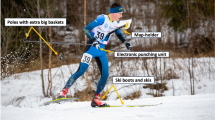Summary
Six healthy male subjects performed a 3-min supramaximal test in four different cycling positions: two with different trunk angles and two with different saddle-tube angles. Maximal power output and maximal oxygen uptake (VO2max) were measured. Maximal power output was significantly higher in a standard sitting (SS, 381 W, SD 49) upright position compared to all other positions: standard racing (SR, 364 W, SD 49), recumbent backwards (RB, 355 W, SD 44) and recumbent forwards (RF, 341 W, SD 54). Although VO2max was also highest in SS (4.31 l · min−1, SD 0.5) upright position, the differences in VO2max were not significant (SR, 4.21 · min−1, SD 0.53; RB, 4.17 l · min−1, SD 0.58; RF, 4.11 l · min−1, SD 0.66). It is concluded that (supra)maximal tests on a cycle ergometer should be performed in a sitting upright position and not in a racing position. In some cases when cycling on the road, higher speeds can be attained when sitting upright. This is especially true when cycling uphill when high power must be generated to overcome gravity but the road speed, and hence the power required to overcome air resistance, is relatively low.
Similar content being viewed by others
References
Åstrand PO, Saltin B (1961) Maximal oxygen uptake and heart rate in various types of muscular activity. J Appl Physiol 16:977–981
Clijsen LPVM, Linden J van den, Welbergen E, Boer RW (1988) Supercompensation in external power of well-trained cyclists. In: Burke E, Newsom MM (eds) Medical and Scientific aspects of cycling. Human Kinetics, Champaign, Ill, pp 133–139
Diaz FJ, Hagan RD, Wright JE, Horvath SM (1978) Maximal and submaximal exercise in different positions. Med Sci Sports 10:214–217
Faria I, Dix Ch, Frazer C (1978) Effect of body position during cycling on heart rate, pulmonary ventilation, oxygen uptake and work output. J Sports Med 18:49–56
Folkow B, Haglung U, Jodal M, Lundgren O (1971) Blood flow in the calf muscle of man during heavy rhythmic exercise. Acta Physiol Scand 81:157–163
Greenleaf JE, Kessel AL van, Ruff W, Card DH, Rapport M (1971) Exercise temperature regulation in man in the upright and supine positions. Med Sci Sports 3:175–182
Greenleaf JE, Montgomery LD, Brock PJ, Beaumont W van (1979) Limb blood flow: rest and heavy exercise in sitting and supine positions in man. Aviat Space Environ Med 50:702–707
Hamley EJ, Thomas V (1967) Physiological and postural factors in the calibration of the bicycle ergometer. J Physiol 191:55 P
Houtz SJ, Fisher FJ (1959) An analysis of muscle action and joint excursion during exercise on a stationary bicycle. J Bone Joint Surg 41-a(1):123–131
Ingen Schenau GJ van, Groot G de (1983) Differences in oxygen consumption and external power between male and female skaters during supramaximal cycling. Eur J Appl Physiol 51:337–345
Ingen Schenau GJ van, Boer RW de, Geijsel JSM, Groot G de (1988) Supramaximal test results of male and female speed skaters with particular reference to methodological problems. Eur J Appl Physiol 57:6–9
Kyle CR, Caiozzo VJ (1986) Experiments in human ergometry as applied to the design of human powdered vehicles. Int J Sports Biomech 2:6–19
Mueller EA (1937) Der Einfluß der Sattelstellung auf das Arbeitsmaximum und den Wirkungsgrad beim Radfahren. Arbeitsphysiologie 10:1–7
Nordeen-Snyder KS (1977) The effect of bicycle seat height variation upon oxygen consumption and lower limb kinematics. Med Sci Sports 9:113–117
Nordeen KS, Cavanagh PR (1975) Simulation of lower limb kinematics during cycling. In: Komi PA (ed) Biomechanics V-B Human Kinetics, Champaign, Ill, pp 26–33
di Prampero PE, Cortili G, Mognoni P, Siabene F (1979) Equation of motion of a cyclist. J Appl Physiol 47:201–206
Pugh LGCE (1974) The relation of oxygen intake and speed in competition cycling and comparative observations on the bicycle ergometer. J Physiol 241:795–808
Sargeant AJ, Davis CTM (1977) Forces applied to cranks of a bicycle ergometer during one- and two-leg cycling. J Appl Physiol Respir Environ Exerc Physiol 42:514–518
Shennum PL, Vries HA de (1976) The effect of saddle height on oxygen consumption during bicycle ergometer work. Med Sci Sports 8:119–121
Stenberg J, Åkstrand PO, Ekblom B, Royce J, Saltin B (1976) Hemodynamic response to work with different muscle groups, sitting and supine. J Appl Physiol 22:61–70
Young JW, Chandler RF, Snow CC, Robinette KM, Zehner GF, Lofberg MS (1983) Anthropometric and mass distribution characteristics of the adult female. FAA-AM-83-16
Whitt FR (1971) A note on the estimation of the energy expenditure of sporting cyclists. Ergonomics 14:419–424
Author information
Authors and Affiliations
Rights and permissions
About this article
Cite this article
Welbergen, E., Clijsen, L.P.V.M. The influence of body position on maximal performance in cycling. Eur J Appl Physiol 61, 138–142 (1990). https://doi.org/10.1007/BF00236708
Accepted:
Issue Date:
DOI: https://doi.org/10.1007/BF00236708




